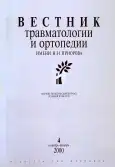Наш опыт лечения врожденного вывиха бедра у детей разного возраста
- Авторы: Малахов О.А.1, Кожевников О.В.1, Грибова И.В.1, Кралина С.Э.1
-
Учреждения:
- Центральный институт травматологии и ортопедии им. Н.Н. Приорова
- Выпуск: Том 7, № 4 (2000)
- Страницы: 26-31
- Раздел: Оригинальные исследования
- URL: https://journals.rcsi.science/0869-8678/article/view/104419
- DOI: https://doi.org/10.17816/vto104419
- ID: 104419
Цитировать
Полный текст
Аннотация
В клинике детской ортопедии ЦИТО более 10 лет используется система комплексного последовательного лечения врожденного вывиха бедра. При поздно диагностированном и не вправленном к 6 мес вывихе применяется функциональная гипсовая повязка по Тер-Егиаза- рову—Шептуну. В случае неэффективности консервативного лечения переходят к вправлению вывиха при помощи скелетного вытяжения по методике «over head». У детей в возрасте от 3 до 13 лет для низведения головки бедра применяется другой вид дистракционной системы. После вправления головки в вертлужную впадину производится операция, направленная на коррекцию бедренного и/или тазового компонента сустава, объем которой зависит от степени его дисплазии. Многолетний опыт показал, что после низведения головки бедра развивается остеопороз, затрудняющий выполнение деторсионно-варизирующей остеотомии бедра. В связи с этим в отделении разработана методика, по которой вначале производятся деторсионно-варизирующая остеотомия бедра с фиксацией пластиной и наложение дистракционной системы, а в последующем осуществляется закрытое вправление вывиха. Результаты лечения изучены в сроки от 1 года до 10 лет у 255 больных. Оценка проводилась по балльной системе, предложенной Г.М. Тер-Егиазаровым и Т.П. Юкиной. Хорошие и удовлетворительные результаты констатированы в 91,7% случаев.
Полный текст
Открыть статью на сайте журналаОб авторах
О. А. Малахов
Центральный институт травматологии и ортопедии им. Н.Н. Приорова
Автор, ответственный за переписку.
Email: info@eco-vector.com
Россия, Москва
О. В. Кожевников
Центральный институт травматологии и ортопедии им. Н.Н. Приорова
Email: info@eco-vector.com
Россия, Москва
И. В. Грибова
Центральный институт травматологии и ортопедии им. Н.Н. Приорова
Email: info@eco-vector.com
Россия, Москва
С. Э. Кралина
Центральный институт травматологии и ортопедии им. Н.Н. Приорова
Email: info@eco-vector.com
Россия, Москва
Список литературы
- Абакаров А.А. Обоснование щадящих методов лечения в системе медицинской реабилитации детей с врожденным вывихом бедра: Дис.... д-ра мед. наук. — Куйбышев,1987.
- Волков М.В., Тер-Егиазаров Г.М., Юкина Г.П. Врожденный вывих бедра. — М.,1972.
- Кисиль И.Ю. Клинико-рентгенологические аспекты врачебно-трудовой экспертизы лиц, перенесших ре- конструктивно-восстановительные операции на тазобедренном суставе в детском возрасте: Дис.... канд. мед. наук. — М.,1991.
- Куценок Я.Б., Рулла Э.А., Мельник В.В. Врожденная дисплазия тазобедренного сустава. Врожденные подвывих и вывих бедра. — Киев,1992.
- Миралимов М.М. Комплексное клинико-рентгенофункциональное исследование, врачебно-трудовая экспертиза и реабилитация лиц с врожденным вывихом бедра после его консервативного лечения: Дис.... канд. мед. наук. — М.,1992.
- Поздникин Ю.И., Камоско М.М. //Заболевания и повреждения тазобедренного сустава: Тезисы докладов науч.-практ. конф. — Рязань,2000. — С. 54-55.
- Соколовский А.М., Крюк А.С. Хирургическое лечение заболеваний тазобедренного сустава. — Минск,1993.
- Guille J., Pizzutillo P.D., MacEwen G.D. //J. Am. Acad. Orthop. Surg. — 2000. — Vol. 8, N 4. — P. 232-242.
Дополнительные файлы











